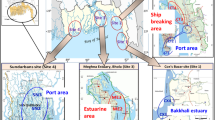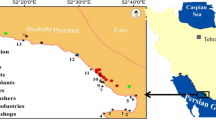Abstract
The study was carried out in Gökçeada, located in the North Aegean Sea in 2017, during winter and summer seasons and the concentrations of 16 polycyclic aromatic hydrocarbon (PAH) components were determined in P. oceanica type seagrass samples. Total PAH (TPAH) values ranged from 190.8 to 7668.7 ng g−1 dw during the sampling period. In addition, the source of pollution was investigated by using PAH ratios. According to the fluoranthene (FA) /pyrene (PY) ratio in the winter period, the origin of pollution is mostly pyrolytic, while in the summer period, according to the fluoranthene (FA) /pyrene (PY) and benzo(a)anthracene (BaA) /chrysene (CHR) ratio, the pollution origin was found to be petrogenic.

Similar content being viewed by others
References
Ancora S, Bianchi N, Butini A, Buia MC, Gambi C, Leonzio C (2004) Posidonia oceanica as a biomonitor of trace elements in the Gulf of Naples: temporal trends by lepidochronology. Environ Toxicol Chem 23:1093–1099 https://doi.org/10.1897/02-590
Apostolopoulou M-V, Monteyne E, Krikonis K, Pavlopoulos K, Roose P, Dehairs F (2014) Monitoring polycyclic aromatic hydrocarbons in the Northeast Aegean Sea using Posidonia oceanica seagrass and synthetic passive samplers. Mar Poll Bull 87:338–344 https://doi.org/10.1016/j.marpolbul.2014.07.051
Balcıoğlu EB (2019) Investigation of anionic detergent and phosphate pollution in the coastal surface water of Gökçeada. Pamukkale Univ J Eng Sci 25(3):280–285 (In Turkish). https://doi.org/10.5505/pajes.2018.65471
Balestri E, Benedetti-Cecchi L, Lardicci C (2004) Variability in patterns of growth and morphology of Posidonia oceanica exposed to urban and industrial wastes: contrasts with two reference locations. J Exp Mar Biol Ecol 308:1–21 https://doi.org/10.1016/j.jembe.2004.01.015
Baumard P, Budzinski H, Garrigues P (1998a) Polycyclic aromatic hydrocarbons in sediments and mussels of the western Mediterranean Sea. Environ Toxicol Chem 17:765–776 https://doi.org/10.1002/etc.5620170501
Baumard P, Budzinski H, Garrigues P (1998b) PAHs in Arcachon Bay France: origin and biomonitoring with caged organisms. Mar Poll Bull 36:577–586 https://doi.org/10.1016/S0025-326X(98)00014-9
Benoit G, Comeau A (2005). Méditerranée – les perspectives du plan bleu sur l’environment et le developpement, PNUE
Budzinski I, Bellocq J, Pierard C, Garrigues P (1997) Evaluation of sediment contamination by polycyclic aromatic hydrocarbons in the Gironde estuary. Mar Chem 58(1–2):85–97 https://doi.org/10.1016/S0304-4203(97)00028-5
Çiftçi-Türetken PS, Altuğ G (2016) Bacterial pollution, activity and heterotrophic diversity of the northern part of the Aegean Sea. Turkey Environ Monit Asses 188 https://doi.org/1-12.10.1007/s10661-016-5109-6
EPA (United States Environmental Protection Agency) (2009) List of Contaminants and their Maximum Contaminant Level (EPA 816-F- 09-0004), 6
European Maritime Safety Agency (EMSA) (2010) Maritime Accident Review 2010. http://www.emsa.europa.eu.
Ferrat L, Bingert A, Romeo M, Gnassia-Barelli M, Pergent-Martini C (2002) Mercury uptake and enzymatic response to Posidonia oceanica after an experimental exposure to organic and inorganic forms. Environ Toxicol Chem 21:2365–2371 https://doi.org/10.1002/etc.5620211115
Gogou A, Apostolaki M, Stephanou EG (1998) Determination of organic molecular markers in marine aerosols and sediments: one-step flash chromatography compound class fractionation and capillary gas chromatographic analysis. J Chromatogr A799:215–231 https://doi.org/10.1016/S0021-9673(97)01106-0
Gogou A, Bouloubassi I, Stephanou G (2000) Marine organic geochemistry of the eastern Mediterranean: 1. Aliphatic and polyaromatic hydrocarbons in Cretan Sea surficial sediments. Mar Chem 68:265–282 https://doi.org/10.1016/S0304-4203(99)00082-1
Gosselin M, Bouquegneau JM, Lefebuie F, Gilles L, Pergent G, Pergent-Martini C, Sylvie G (2006) Trace metal concentrations in Posidonia oceanica of North Corsica (northwestern Mediterranean Sea): use as a biological monitor? BMC Ecol 6:1–19 https://doi.org/10.1186/1472-6785-6-12
Gönülal O, Öz İ, Güreşen SO, Öztürk B (2016) Abundance and composition of marine litter around Gökçeada Island (northern Aegean Sea). Aquatic Eco Health Manag 19(4):461–467 https://doi.org/10.1080/14634988.2016.1257898
Gschwend PM, Hites RA (1981) Fluxes of the polycyclic aromatic compounds to marine and lacustrine sediments in the northeastern United States. Geochim Cosmochim Acta 45:2359–2367 https://doi.org/10.1016/0016-7037(81)90089-2
Haynes D, Muller J, Carter S (2000) Pesticide and herbicide residues in sediments and seagrasses from the great barrier reef world heritage area and Queensland coast. Mar Poll Bull 41:279–287 https://doi.org/10.1016/S0025-326X(00)00097-7
Hemminga MA, Duarte CM (2000) Seagrass ecology. Cambridge University Press, Cambridge
Lafabrie C, Pergent G, Kantin R, Pergent-Martini C, Gonzalez JL (2007) Trace metals assessment in water, sediment, mussel and seagrass species—validation of the use of Posidonia oceanica as a metal biomonitor. Chem 68:2033–2039 https://doi.org/10.1016/j.chemosphere.2007.02.039
Lewis MA, Devereux R (2009) Review non-nutrient anthropogenic chemicals in seagrass ecosystems: fate and effects. Environ Toxicol Chem 2:644–661 https://doi.org/10.1897/08-201.1
Lopez y Royo C, Pergent G, Pergent-Martini C, Casazza G (2007) Monitoring Posidonia oceanica in the Mediterranean: Datawarehousing approach. In: El Asmi S, La Ravallec C (eds) Pergent- Martini, C. RAC/SPA, Tunis, pp 96–103
Malea P, Haritonidis S, Kevrekidis T (1994) Seasonal and local variations of metal concentrations in the seagrass Posidoniu oceanica (L.) Delile in the Antikyra gulf, Greece. Sci Total Environ 753:225–535 https://doi.org/10.1016/0048-9697(94)90202-X
Oral N, Öztürk B (2006) The Turkish straits, maritime safety, legal and environmental aspects. Turkish marine Research Foundation, _Istanbul. Publication no. 25. In: Abdulla A, Linden O (eds) Maritime traffic effects on biodiversity in the Mediterranean Sea: review of impacts. Priority Areas and Mitigation Measures. IUCN Centre for Mediterranean Cooperation, Malaga, Spain, p 184
Pergent-Martini C, Pergent G (2000) Marine phanerogams as a tool in the evaluation of marine trace-metal contamination: an example from the Mediterranean. Int J Environ Poll 13:126–147 6:949–953. https://doi.org/10.1504/IJEP.2000.002313
Pergent G, Pergent-Martini C, Casalta B, Lopez y Royo C, Mimault B, Salivasdecaux M, Short F (2007) Comparison of three Seagrass monitoring systems: Seagrassnet Posidonia Programme and RSP. In: El Asmi S, La Ravallec C (eds) Pergent-Martini, C. RAC/SPA, Tunis, pp 141–150
Pergent G, Céline Labbe C, Lafabrie C, Kantin R, Pergent-Martini C (2011) Organic and inorganic human-induced contamination of Posidonia oceanica meadows. Ecol Eng 37:999–1002 https://doi.org/10.1016/j.ecoleng.2011.02.001
Stella A, Piccardo MT, Coradeghini R, Redaelli A, Lanteri S, Armanino C, Valerio F (2002) Principal component analysis application in polycyclic aromatic hydrocarbons “mussel watch” analyses for source identification. Anal Chim Acta 461: 201–213. https://doi.org/https://doi.org/10.1016/S0003-2670(02)00274-X
Short FT., Coles RG, Pergent-Martini C (2001) Global Seagrass distribution, global Seagrass research methods. In: Short, F.T., Coles, R.G. (Eds.) Amsterdam, pp 5–30
Usero J, Morillo J, Gracia I (2005) Heavy metal concentrations in molluscs from the Atlantic coast of southern Spain. Chemosphere 59: 1175–1181. https://doi.org/https://doi.org/10.1016/j.chemosphere.2004.11.089
Warnau M, Fowler SW, Teyssie JL (1996) Biokinetics of selected heavy metals and radionuclides in two marine macrophytes: the seagrass Posidonia oceanica and the alga Caulerpa taxifolia. Mar Environ Res 41:343–362 https://doi.org/10.1016/0141-1136(95)00025-9
Acknowledgements
The author thanks Sedat Ozan Güreşen (M.Sc.) for collecting samples with scuba diving, Assoc. Prof. Onur Gönülal for his kind help and Istanbul University Scientific Research Unit for supporting with the project number of 21681.
Author information
Authors and Affiliations
Corresponding author
Ethics declarations
Conflict of Interest
The author(s) declared no potential conflicts of interest with respect to the research, authorship, and/or publication of this article.
Additional information
Publisher’s Note
Springer Nature remains neutral with regard to jurisdictional claims in published maps and institutional affiliations.
Rights and permissions
About this article
Cite this article
BALCIOĞLU, E. Determination and Origin Apportionment of Polycyclic Aromatic Hydrocarbons (PAHs) in Posidonia oceanica Samples around Gökçeada. Thalassas 37, 51–56 (2021). https://doi.org/10.1007/s41208-020-00255-3
Received:
Revised:
Accepted:
Published:
Issue Date:
DOI: https://doi.org/10.1007/s41208-020-00255-3




